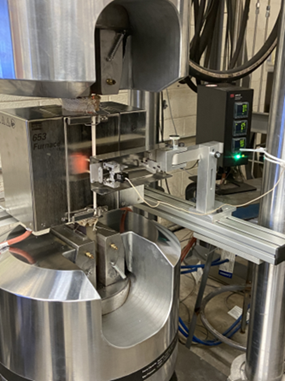Summary
This project aims to develop validated computational tools and technical guidance to enable performance-based structural fire resistance design, moving beyond current prescriptive methods for building fire safety and ensuring safer and more cost-effective structural fire designs for buildings in the US. The project develops scientific information on how fires affect the performance of common engineering and commercially available fire-insulating materials and structural connections and utilizes results of real-scale fire experiments from the companion project, Measurement of Structural Performance in Fire, to validate the modeling approach.
Description

Experimental setup for quantification of Butt welds performance at elevated temperatures.
Objective
To produce validated computational tools and technical guidance enabling the development of performance-based standards for the cost-effective fire resistance design and assessment of structures.
Technical Idea
This project will develop a methodology for integrating fire as a design condition in building design, thus enabling performance-based design (PBD) tools and guidelines for structural fire safety. Current prescriptive methods for building design and evaluation cannot accurately assess structural performance in fire, as buildings are designed for natural hazards but only protected against fire effects. This project will collaborate with the National Fire Research Laboratory (NFRL), who will conduct real-scale structural fire experiments of common building systems through the “Measurement of Structural Performance in Fire” project to study the effects of fire exposure to structural members, systems, and connections subjected to realistic fire conditions. Data from these fire experiments will be used to validate high-fidelity, nonlinear computational models that account for temperature-induced material degradation and thermal expansion effects. The advanced, validated computational model will be simplified in ways that ensure the accuracy of the performance prediction to enable wider application in structural fire safety design in practice. Additional experiments will be conducted to assess how temperature exposure affects concrete and cementitious insulating materials.
Research Plan
This project aims to develop a performance-based framework for evaluating building fire performance by integrating new and existing knowledge on structurally significant fires, material behavior, and structural response to thermal-structural loading. The project will focus on:
- Validated Computational Modeling – Develop and validate thermal-structural analysis tools for buildings, leveraging NFRL’s fire experiments on composite frames and beams.
- Material & Connector Characterization – Establish high-temperature behavior data for materials (e.g., steel welds, insulation, concrete) and connections.
- Uncertainty Quantification – Assess and propagate uncertainties from fire simulations to structural analysis, aiding reliability assessment.
- Design Methodologies – Develop a performance-based framework incorporating probabilistic fire scenarios and improved prescriptive design guidelines.
Testing will include a two-story steel gravity frame (two bays × three bays) with a composite concrete slab-steel deck floor system. A 6.1 m × 9.1 m (20 ft × 30 ft) test bay will be hydraulically loaded to simulate service conditions. Composite floors are widely used but pose modeling challenges due to fire-induced weakening. The study will analyze symmetry, geometry, connections, thermal expansion restraint, and fire exposure. Pre- and post-test modeling will refine design tools for engineers.
Prior to full-scale testing, five long-span composite beams were tested to examine failure modes and connections under fire exposure.
- Computational Modeling – Predict structural response pre-test for experiment planning and validation post-test to refine modeling accuracy. Develop methods for coupling fire-thermal-structural models.
- Material & Connector Behavior – Develop high-temperature test protocols and identify key experimental needs. Conduct testing to quantify uncertainties in material and structural responses under fire conditions.
- Uncertainty Analysis – Identify dominant uncertainties in fire loading, material behavior, and boundary conditions. Develop load and resistance factors for structural fire design.
- Performance-Based Design – Establish a framework linking fire intensity to structural performance across risk categories. Improve prescriptive design standards using advanced modeling results.
This research will enhance fire-resistant structural design, providing engineers with validated tools for safer, performance-driven building fire assessments.
Major Accomplishments
- Publication: Morovat, M.A., Main, J.A., Weigand, J.M., Sadek, F., and Phan, L.T. (2024). “A computational modeling approach for steel gravity frames with composite floor systems subjected to fire.” 13th International Conference on Structures in Fire, U. Coimbra, Portugal, June 2024. Selected for a Special Issue of the Fire Safety Journal.
- Publication: Mohammed Morovat, Joseph Main, Jonathan Weigand, Malcolm Ammons, Fahim H. Sadek, Long Phan; “Analysis of a Steel Gravity Frame with Composite Floor System Subjected to Compartment Fire (Test #2),” NIST TN 2269.
- Publication: Ammons, M. and Weigand, J. M. (2024), “Elevated Temperature Properties of Steel Butt Weldments.” Journal of Constructional Steel Research, Volume 215, April 2024.
- Proposal for AISC Specification’s commentary on retention factors for steels at elevated temperatures based on the above NIST publication by Ammons, M. and Weigand, J. M. (2024) in the Journal of Constructional Steel Research was adopted by AISC.

